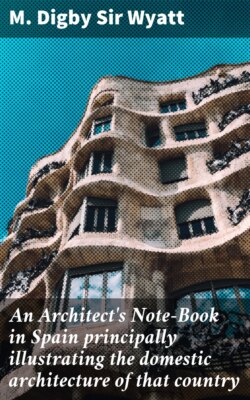Читать книгу An Architect's Note-Book in Spain principally illustrating the domestic architecture of that country - Sir M. Digby Wyatt - Страница 12
На сайте Литреса книга снята с продажи.
VALLADOLID. DETAIL FROM THE "PATIO DE SAN GREGORIO."
ОглавлениеTHE portion of the great Dominican Convent of Valladolid which formed the subject of the last sketch, is supposed to have been the commencement of a second Patio, or courtyard, around which were to have been arranged apartments, mainly intended for the reception of guests or visitors, lay as well as ecclesiastic. The arcading, of which Plate IV is a sketch, surrounds the great Patio of the monastic establishment of which the "Colegio" proper is the Church. Around this noble courtyard were grouped the apartments in which resided the powerful Black Friars—so called from their dress—worthy adherents to the traditions of the founder of the Order, himself an old Castilian, whose activity as Preachers, and still more as Inquisitors, made them, perhaps, even more powerful in controlling the destinies of the Peninsula than the political heads of the State. The first stone of this great establishment, dedicated to St. Gregory, and founded by Alonso of Burgos, Bishop of Palencia, was laid in the year 1488. Some idea of the rapid growth and elevation of the Dominicans about this period may be derived from an observation of the fact that this splendid Church and Monastery was the second great establishment of the Order in Valladolid completed within the space of about ten years. Cean Bermudez tells us that the Cardinal Don Juan Torquemada caused the Church of the Convent of St. Paul to be erected, which, with its façade of excellent architecture, was finished in the year 1463.
The work at Saint Gregory lasted about eight years, a very short time, considering not only the quantity and extent of labour involved in the mere construction, but the amount of intricate and elaborate sculpture which decorates the façade of the Church. Its architect, Macias Carpintero, of Medino del Campo, is placed by Llaguno y Amirola upon a footing, as to merit, with the celebrated architects Siloe and Cruz of Cologne, who introduced extraordinary elaboration into the ornamental carving of Spain. The fate of Macias was a sad one, since on the last Saturday in July, in the year 1490, while working himself, and directing this great architectural work, he committed suicide, infinitely to the surprise and regret of the monks and their fellow-citizens.
Some idea of the scale upon which the Patio of San Gregorio is worked out, may be derived from a knowledge of the facts, that the lower arcade is about twenty feet high, and the upper fifteen feet. The open space enclosed by the arcading is very large, and the distance from centre to centre of each of the pillars about nine feet.
